What switching options are available for the AMP1?
The AMP1 can be operated in different ways, depending on the application and expansion level. The scalability of the AMP1 system is also reflected in the versatility of the switching options:
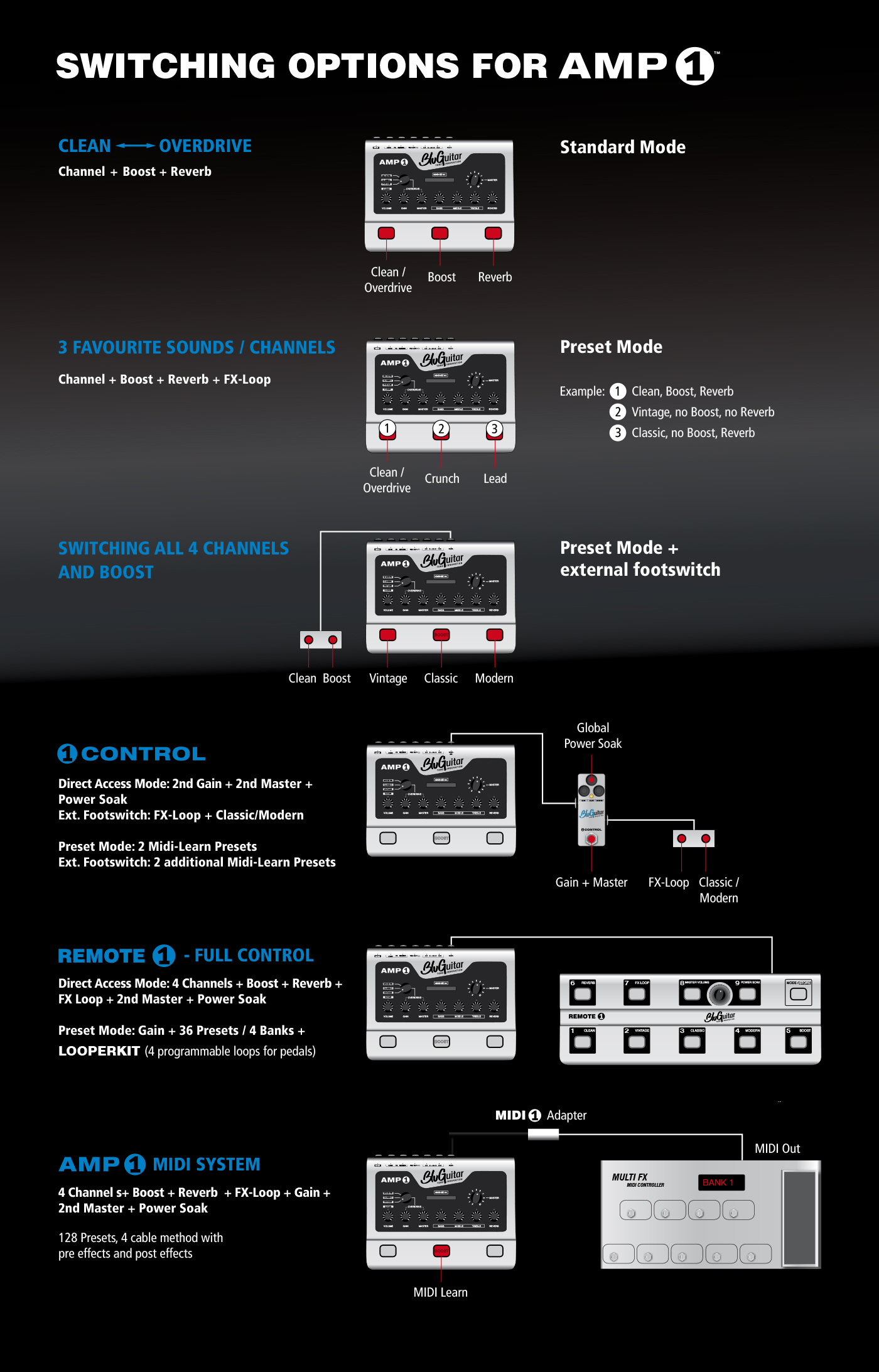
Here is an overview of the available switching options:
Standard Mode / Direct Access Mode
In Direct Access Mode or Standard Mode, the left footswitch always switches between CLEAN and OVERDRIVE, the middle footswitch turns the BOOST on and off, and the right footswitch turns the REVERB on and off.
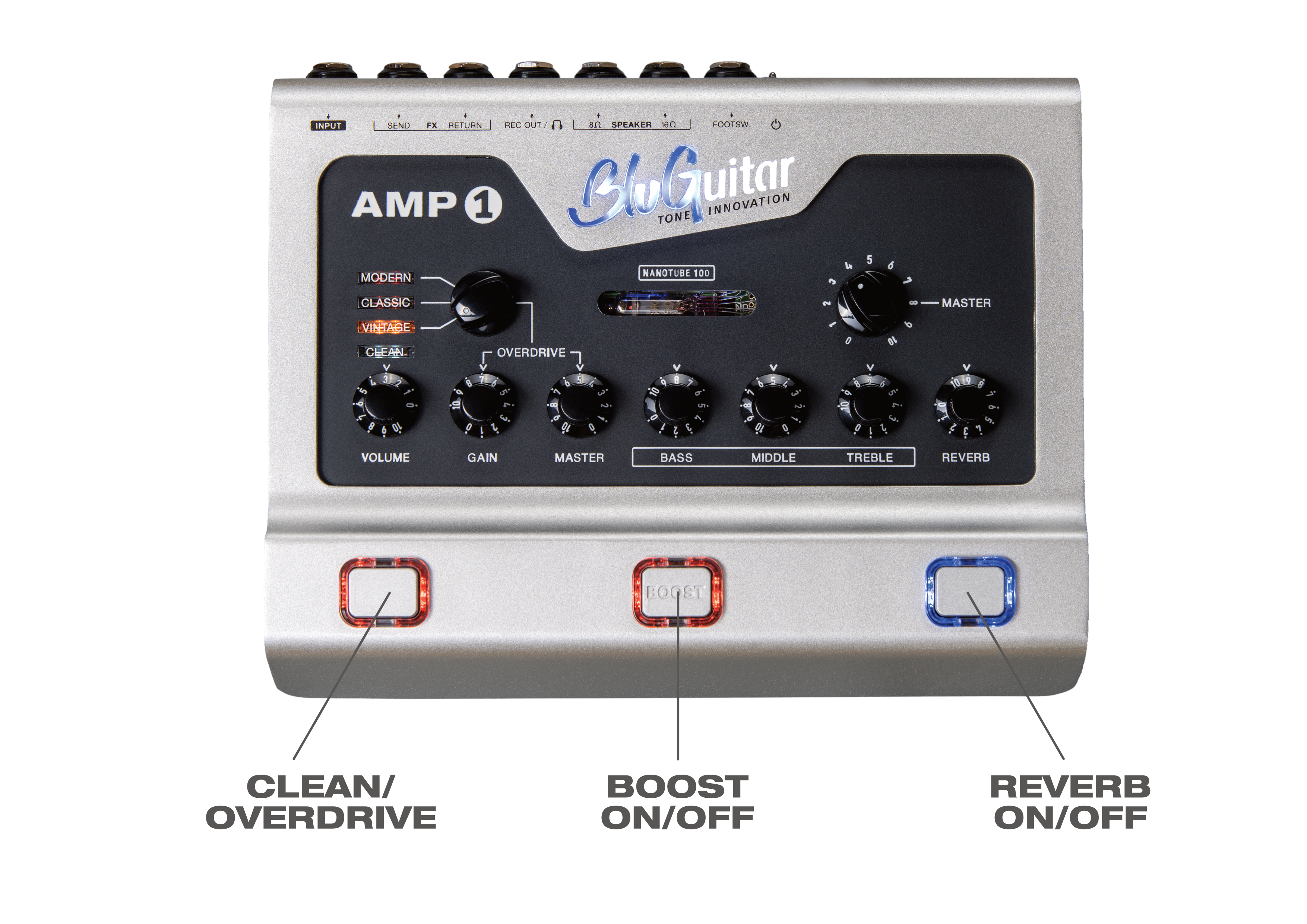
Preset Mode
In Preset Mode you can save any combination of channel selection (CLEAN, VINTAGE, CLASSIC, MODERN), BOOST (on/off) and REVERB (on/off) on each of the three foot switches. The settings are retained even after switching off. The following setting is programmed at the factory:
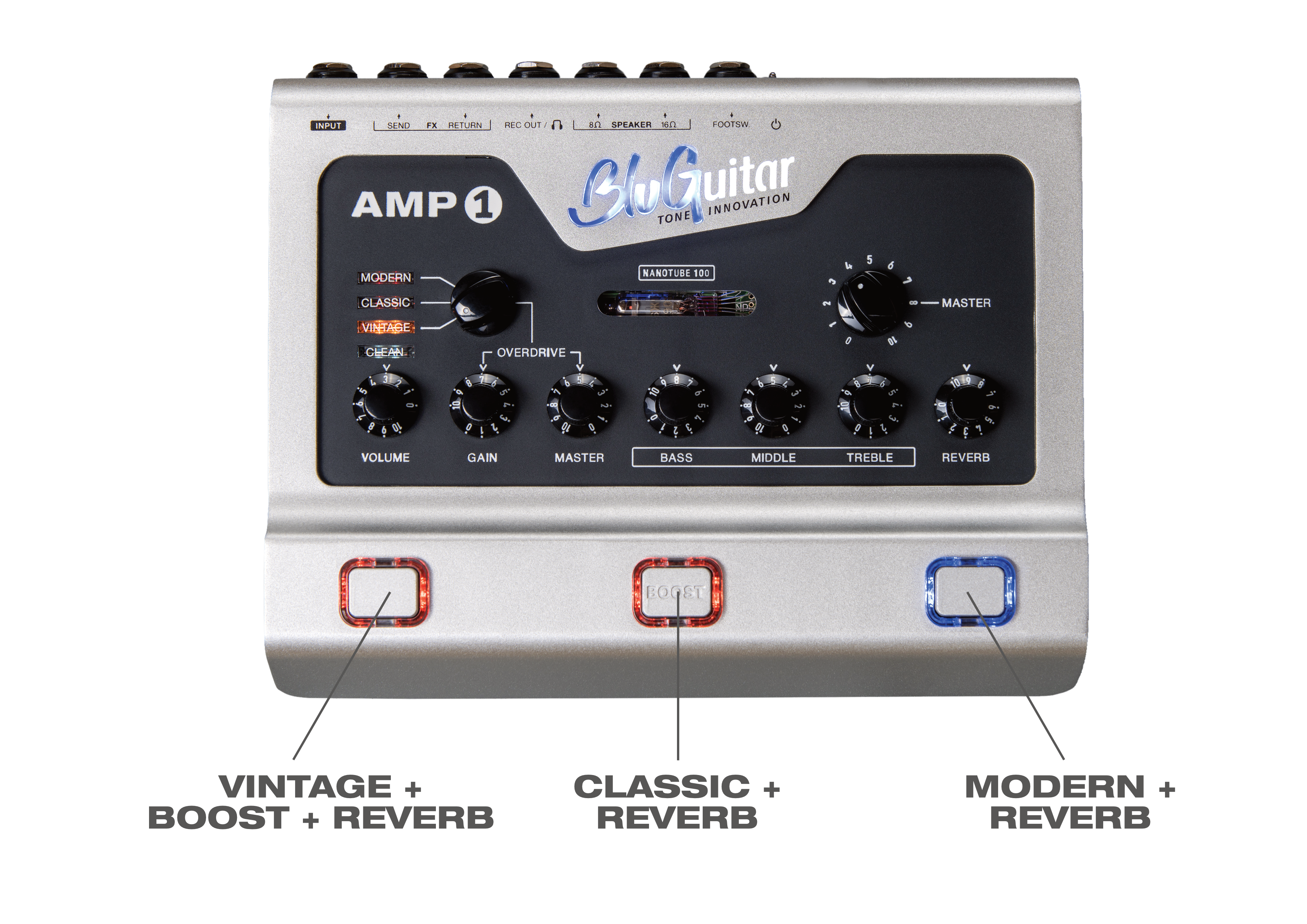
Preset Mode + external foot switch
You can connect a normal 2-way footswitch with a stereo jack plug to the footswitch connection of the AMP1 - in addition to the REMOTE1 and the MIDI1 adapter. The two switches of the external footswitch then take over the respective functions of the left and middle internal footswitches of the AMP1 in Direct Access Mode, i.e. CLEAN/OVERDRIVE and BOOST on/off. A mono footswitch can also be used. This then switches between clean and overdrive, i.e. takes over the function of the left internal footswitch of the AMP1 in Direct Access Mode
This option is particularly useful if you want access to all 4 channels of the AMP, but are not using the REMOTE1 or MIDI. To do this, you assign presets to the three internal foot switches in Preset Mode, where each of the three switches calls up a different overdrive channel, e.g. VINTAGE for the left switch, CLASSIC for the middle switch and MODERN for the right switch - each with BOOST and/or REVERB on or off as desired. The double foot switch then gives you access to the CLEAN channel and thus to all 4 channels. The second switch on the external double foot switch can also be used to switch BOOST on and off for each channel or preset.
You can find out which foot switches are suitable and which are not here: AMP1 + external foot switch - Why don't all foot switches work with LEDs?
1 Control
With the 1Control you get (in combination with a 2-way foot switch) 3 additional features.
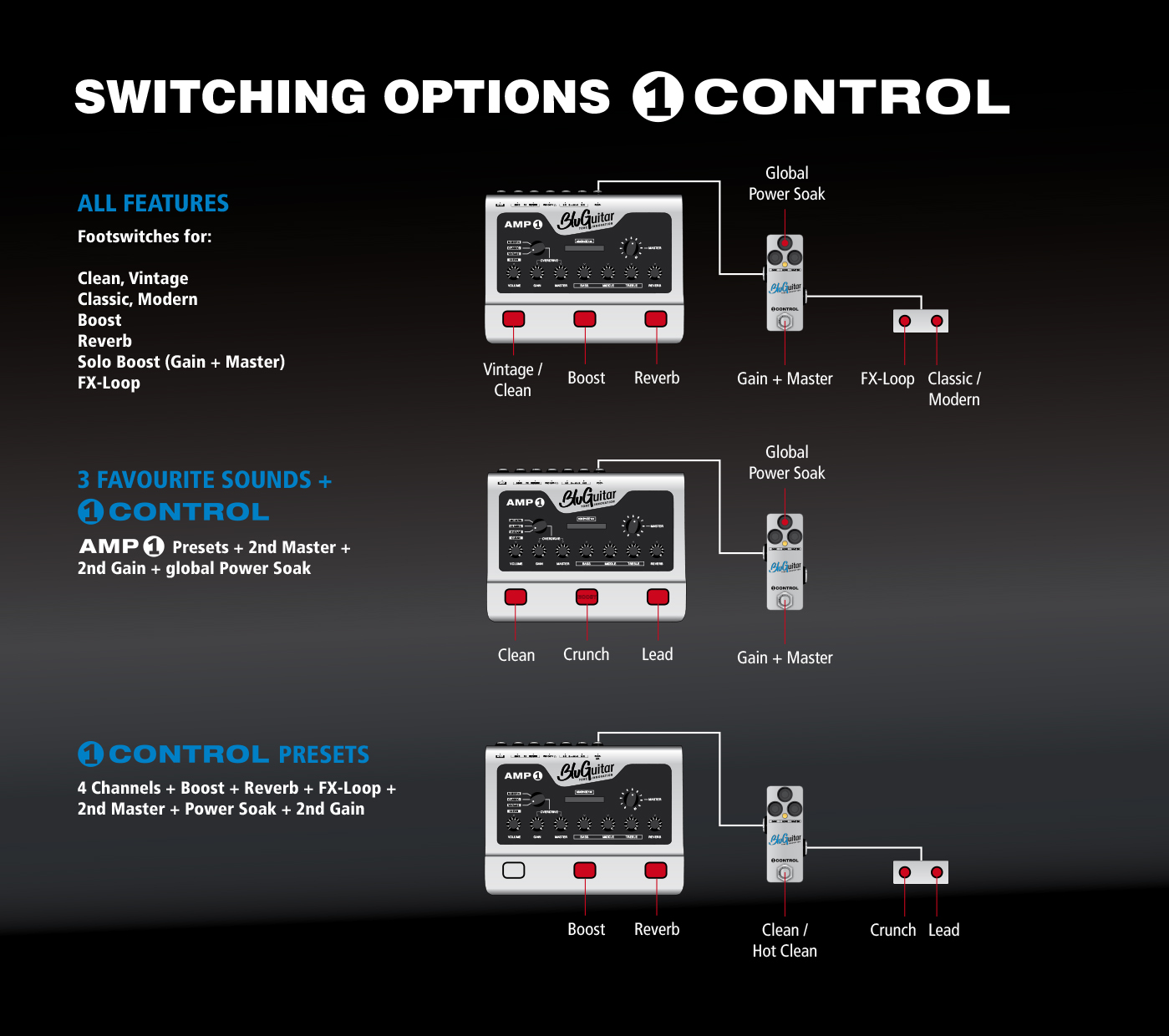
The 1Control is ideal for smaller pedal boards.
DeleteRemote 1
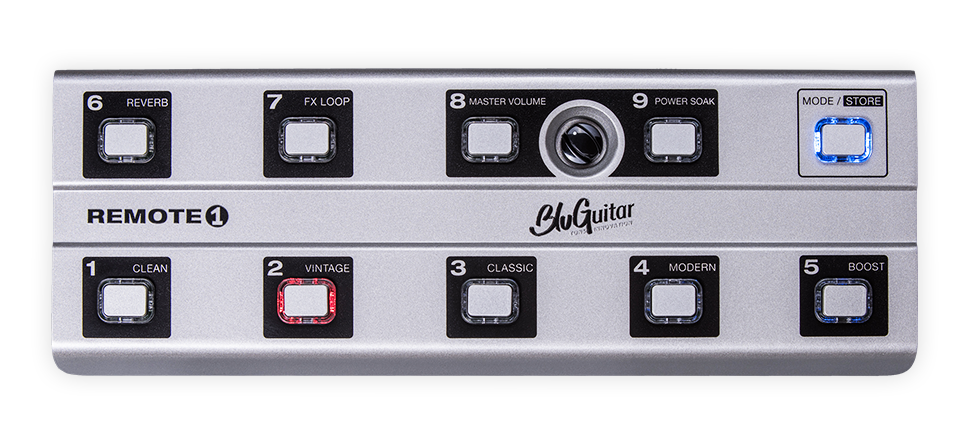
Using the REMOTE1 , all functions of the AMP1 can be selected directly via nine switches and saved in four banks of nine presets each. In addition to direct access to all functions of the AMP1, the REMOTE1 expands the functions of the AMP1 to include a second adjustable master volume and an adjustable and switchable power soak. In addition, the gain for all 4 channels can be saved separately for each preset.
Here you will find an overview of all parameters that can be controlled and saved with the REMOTE1.
DeleteMIDI
How does MIDI LEARN work?
When a MIDI controller is connected to the AMP1 via the BluGuitar MIDI1 adapter, ...
If a MIDI controller is connected to the AMP1 via the BluGuitar MIDI1 adapter , all switching states of the AMP1 can be recalled by a MIDI program change command sent on MIDI channel 1. This allows up to 128 presets to be created. The MIDI LEARN function saves the current setting of the AMP1 when a program change command is received. Each time the AMP1 receives this program change again, the previously saved setting is recalled.
Creating presets with MIDI LEARN
Set the sound (or switching states) you want to save on the AMP1:
- desired channel (CLEAN, VINTAGE, CLASSIC, MODERN)
- BOOST on/off
- REVERB on/OFF
- FX loop on/off (AMP1 Mercury Edition and AMP Iridium Edition only)
When the MIDI1 adapter is plugged in, MIDI LEARN is activated by a long press on the BOOST switch. The flashing of the REVERB LED signals that the AMP1 is "armed" and waiting for a MIDI command. If a valid and unique MIDI program change command is received within 10 seconds, the combination of switching states set above is saved as a preset and the REVERB LED stops flashing. The preset is now called up every time the MIDI program change command assigned to it is sent to the AMP1 on MIDI channel 1.
Fine-tuning the sound
By including 2ND GAIN , 2ND MASTER and POWERSOAK in the MIDI LEARN preset, each preset can be fine-tuned.
In addition to the switching functions mentioned above, the AMP1 offers the parameters 2ND GAIN, 2ND MASTER and POWERSOAK, which are saved with each preset. These parameters are controlled via MIDI Control Change commands (MIDI CC), provided the MIDI device supports this. ( Which parameters on the AMP1 can be controlled via MIDI Control Change (CC)? )
These parameters can be set and saved together with the sound. The AMP1 will then recall them with the preset.
Once set, 2ND GAIN, 2ND MASTER and POWERSOAK will be applied to each preset being learned. To obtain individual Control Change parameters for each preset, the Control Change parameters must be re-sent before executing MIDI LEARN.
Note: When the AMP1 is used with the MIDI1 adapter connected, Low Gain Mode, Low Power Mode and Preset Mode are disabled.
Attention: If MIDI LEARN does not work on the AMP1 Silver Edition , the AMP1 is most likely a device from the very first production batch that is equipped with the "Direct Access" MIDI software. In this case, this article will help you: MIDI LEARN does not work .